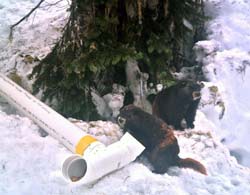Weak and emaciated, she emerged into a world of white. Unable to find the food and warmth she needed to recover from her long hibernation, she lay perfectly still.
Her name is Wascana. She is one of a very rare and endangered species of marmot found only in Canada. And mercifully for this little marmot, her luck didn’t run out along with her strength that day. Levon Young, a Mount Washington Electrician, spotted Wascana and noticed she wasn’t moving. Knowing just how special this little marmot is, he notified the marmot crew, who were on the mountain for avalanche safety training that day.
Wascana is a Vancouver Island Marmot. A species that evolved over thousands of years to survive the deprivation a long hibernation demands, allowing them to fill a unique niche in their alpine habitat where extreme conditions are standard fare.
From October to April, when their alpine habitat becomes ‘uninhabitable,’ the marmots go to sleep. A sleep so deep their heartbeat slows to just 3 or 4 beats per minute. This process of ‘shutting down’ allows the marmots to preserve their energy, stored as fat gained during the summer months, and avoid the worst of the alpine weather. Even then, a wild marmot will lose up to one-third of their body mass before spring arrives.
And Wascana is not a wild-born marmot. She is captive-born, and part of a national breeding program producing healthy, Vancouver Island Marmots for reintroduction to the wild to recover the endangered population. And, while the release of captive-born marmots has successfully increased the Vancouver Island population from a low of less than 30 marmots in the wild in 2003 to between 320-370 in the wild today, the prolonged cold springs of the last few years have taken a huge toll on the ‘inexperienced’ captive-born marmots during their first hibernation in the wild.
Malcolm McAdie, a wildlife veterinarian for the Marmot Recovery Foundation, raced to the scene to see if Wascana could be revived. On first examination, he thought he was too late to save her. Then he noticed an almost imperceptible movement.
Carefully wrapping her in an emergency blanket, he rushed Wascana to the Mount Washington Marmot Recovery Centre, administered fluids, and slowly raised her body temperature. And just when it looked like her chances were lost, Wascana revived, and began eating on her own.
Wascana is just one small marmot. But her story helps illustrate some of the hurdles to overcome when recovering a species from the brink of extinction. All species develop their own unique set of characteristics that allow them to adapt and endure in their specific environments. Replicating those characteristics is next to impossible, making recoveries complex, expensive and challenging. The lesson to be learned from this indomitable little marmot; is to cherish and protect our species and their habitats before they become critically endangered, because the way back home – can be a long and arduous one.
If you would like to help Wascana and other Vancouver Island marmots be restored to their natural habitat on Vancouver Island, please visit the marmot website and make a donation today at www.marmots.org or use the mail-in coupon provided in this paper.
